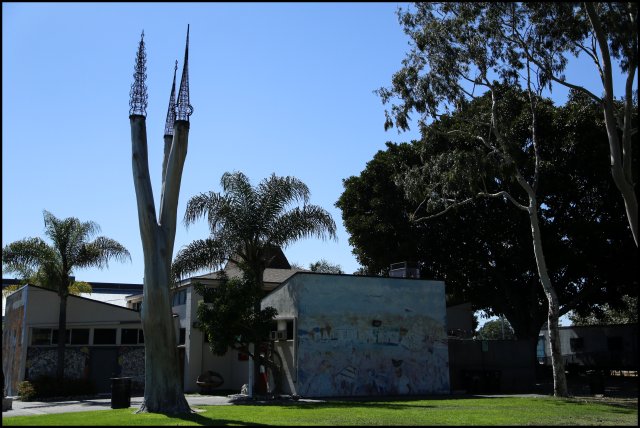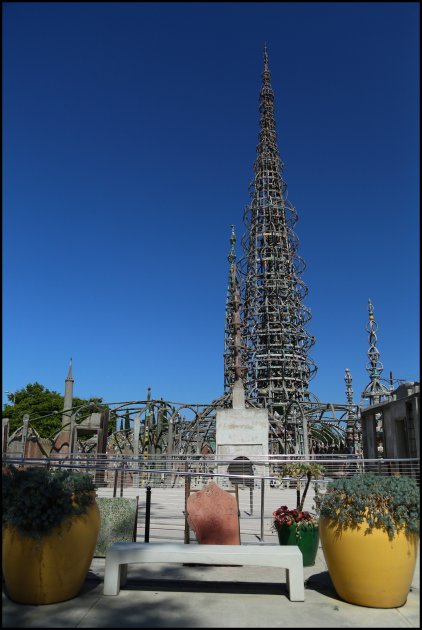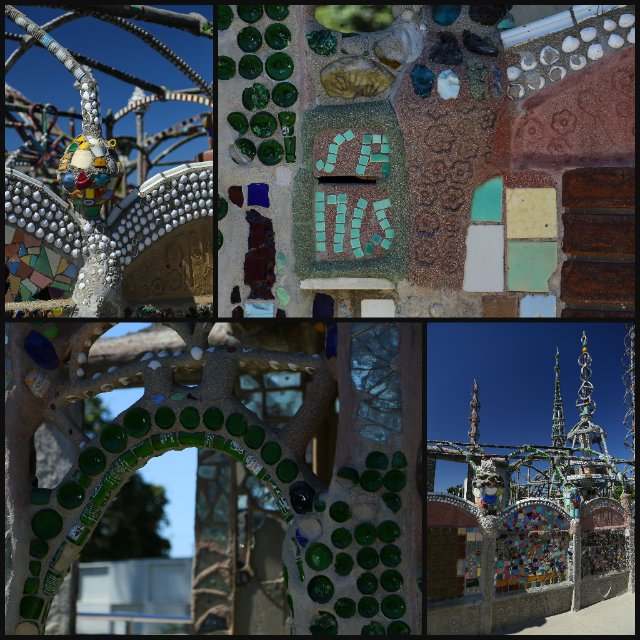While I hadn't heard of the Watts Towers, I do remember the Watts Riots of 1965. During the DUI arrest of an African-American woman by a white California Highway Patrolman, the already strained relationship between the community and the police exploded and the crowd became violent which ignited a large-scale riot in the community of Watts. For six days rioters overturned and burned cars and damaged property. The National Guard was mobilized and curfews were established to restore order. Thirty-four people died, over a thousand were injured and nearly four thousand were arrested. An investigation showed that the Watts neighborhood residents had a long-standing discontentment with substandard schools, inadequate housing and unemployment which officials believed were the real reasons for the riots. Ironically, nothing was ever done to correct those situations.
But back to the Watts Towers. They are located on a residential street in the community of Watts. As we exited the freeway and drove to the address of the towers, the neighborhood... declined... and became scarier-looking. The actual street the towers are located on has several small homes with beautifully maintained yards and friendly people - all African-American. And in the distance, we could hear gun fire. It was one of the very few times I've been aware of my skin color.
Since we had just missed the last tour (blame the LA traffic! ;-)), we spent some time in the visitor's center when we got there. They have a short movie and an interesting civil rights museum.
We thought the towers on the dead tree were pretty interesting!
The towers are just a short walk from the Visitor's Center and are surrounded by a wire fence. We couldn't go in the fenced area (it was after the tour time) but could see quite well through the fence.
From a distance they don't look all that special.
The Watts Towers, which are really nine major sculptures constructed of structural steel and covered with mortar, are the work of one man - Simon Rodia. He was born around 1875 in Rivottoli, Italy. His family immigrated to the U.S. in the 1890's and settled in Pennsylvania where Rodia worked in the coal mines. He later ventured west, working along the way in rock quarries, logging and railroad camps, as a construction worker and sometimes as a tile setter.
In 1921, he purchased the triangular lot at 1765 East 107th Street in Los Angeles. The neighborhood was a thriving working-class community of a wide variety of ethnic backgrounds. Later, WWII changed the demographics as his Japanese neighbors were sent to internment camps and their homes bought up for cheap housing for labor and defense industries. The end of the war brought high unemployment and poverty to the largely unskilled, black neighborhood.
As soon as he moved in to his new house in the early 1920's, Rodia immediately began constructing his masterpiece which he called "Nuestro Pueblo" - Spanish for "our town." Working by himself, without machine equipment, scaffolding, bolts, rivets, welds or even drawing board designs he built his towers using his own creativity, tile setter's tools, and a window washer's belt.
His day job was construction but on his off-time Rodia was an artist adorning his towers with an elaborate mosaic of broken glass, sea shells, rocks,broken pieces of mirror, generic pottery, tile, marble and ceramics. He was the original "up-cycler" creating something new out of discarded, unwanted items.
The three tallest towers are 55-feet tall, 97-feet 10-inches tall and 99-feet 6-inches tall. These towers all contain a large center column extending from the base to the top. Remember that he built these without scaffolding, using a window-washer's belt to hold his tools as he climbed up the tower. He tied his reinforcements together with wire and then painstakingly wrapped them with steel mesh before covering them with his special mortar mixture and quickly adding the mosaic pieces.
It was fun to look for familiar objects (the green 7-Up bottles, sea shells, a broken tea cup) in the mosaic along the wall and arches. His initials (SR) and address number (1765) are embedded in the mosaic every so often, like an artist signing his masterpiece.
Do you think it sounds a little rickety? The City of Los Angeles thought so and in 1957 issued an order to remove the towers calling them "unsafe." However, a 10,000-pound pressure stress test in 1959 proved the towers were safe and could withstand a force equal to that of an 80 mph wind. It wasn't until the Northridge earthquake in 1994 that the towers were damaged and then repaired.
In 1955, Rodia gave the deed to his home (and the towers) to his neighbor and moved to Martinez, California to be near his family. He died there in 1965. In 1959, while the City of Los Angeles was trying to tear the towers down, William Cartwright and Nicholas King bought the property and formed the Committee for Simon Rodia's Towers in Watts. In 1963, the Watts Towers were designated a Los Angeles Cultural Heritage Monument and in 1975, the Committee for Simon Rodia's Towers in Watts deeded the property to the City of Los Angeles. In 1977, it was placed on the National Register of Historic Places and in 1990, was designated a National Historic Landmark.
I cannot imagine climbing to the top of those towers without being attached to a safety harness or having scaffolding to stand on!
So what am I thankful for? Several things, actually. First, that one man wanted to beautify his "not so posh" neighborhood and created an artistic masterpiece everyone, regardless of economic status, could enjoy. It was something that united the neighborhood rather than causing more divisiveness. Remember the Watts Riots? Despite the violence and destruction in Watts, the Towers were untouched. Secondly, that even 60 years later, the Towers have inspired others in the neighborhood to beautify their yards, to create their own "masterpieces." Walking down the street we admired beautiful rose gardens, intricately paved walkways, a beautiful "up-cycled" bird bath, ivy-covered arches. And it all started with one person. And lastly, that the Towers bring more affluent people into this mostly poverty-stricken neighborhood. It's easy to stay in your own neighborhood and pretend that poverty and brokenness don't exist in your town.
But the truth is they exist everywhere. And so does beauty.





No comments:
Post a Comment